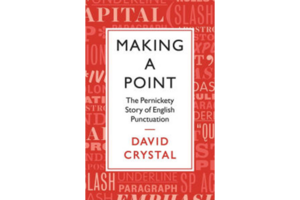Pointing our way to clear communication
A look at the surprisingly fascinating history of punctuation.

'Making a Point' is by David Crystal.
In the beginning were the words, and the words were all runtogetherlikethis: Scholars speak of the breaking up of a line of text into individual words as “the first punctuation.”
And once there were spaces between words, there were places to insert commas, periods, and other clarifying marks.
This surprisingly fascinating story is the subject of a forthcoming book, “Making a Point: The Persnickety Story of English Punctuation.” The author is David Crystal, a popular (in both senses) British linguist whose work has been mentioned here before. He describes two approaches to this endeavor of punctuation.
One is what we might call rhetorical punctuation, or punctuation as stage direction: an aid to reading aloud, almost a form of musical notation.
The other approach is more grammatical: punctuation to elucidate structure, for instance, by setting less important information off within parentheses. This approach is more relevant for silent reading, especially of the kind of text that one processes better when one reads it for oneself, and rereads as needed. But this approach may also omit certain commas as grammatically “unnecessary,” for instance, even when a reader aloud of the passage would surely pause for breath.
Another of Mr. Crystal’s themes is the balance of power between authors and those who publish them. Crystal divides authors into two camps. Some are clueless about the rules and grateful for the help they get from editors: Wordsworth, for example. Others have strong views and expect to impose them: Ben Jonson, for instance.
At a time when the church was the publishing industry’s prestige client, and the printing of plays was a sort of stepchild, Jonson was that rare playwright who actually knew and moreover cared about correct punctuation. He cared so deeply, in fact, that he characteristically signed his name with a colon in the middle: “Ben:Jonson.” And he would drop by the print shop to insist on his own way of doing things.
Mark Twain was of evidently the same school of thought. Crystal quotes his response to a report that a proofreader was “improving” his punctuation: “I telegraphed orders to have him shot without giving him time to pray.”
“Making a Point” gives a new view of Jane Austen, too. Much of her “polished style” seems to have been the work of an intervening copy editor. Original manuscripts show her full of exuberant idiosyncrasy – rather like Emily Dickinson. And Crystal makes the case that Dickinson, too, without her dashes, just isn’t the same.
But a third theme of Crystal’s is that however the dance between author and editor plays out, sometimes there just isn’t a perfect answer to a punctuation question. “ ‘Rules only take us so far, even good rules.’ ”
That’s Crystal quoting Kurt Vonnegut, explaining why he has chosen to use a semicolon after advising that a writer never should.
“That sentence,” Crystal adds, “should be the motto for any work on punctuation.”

